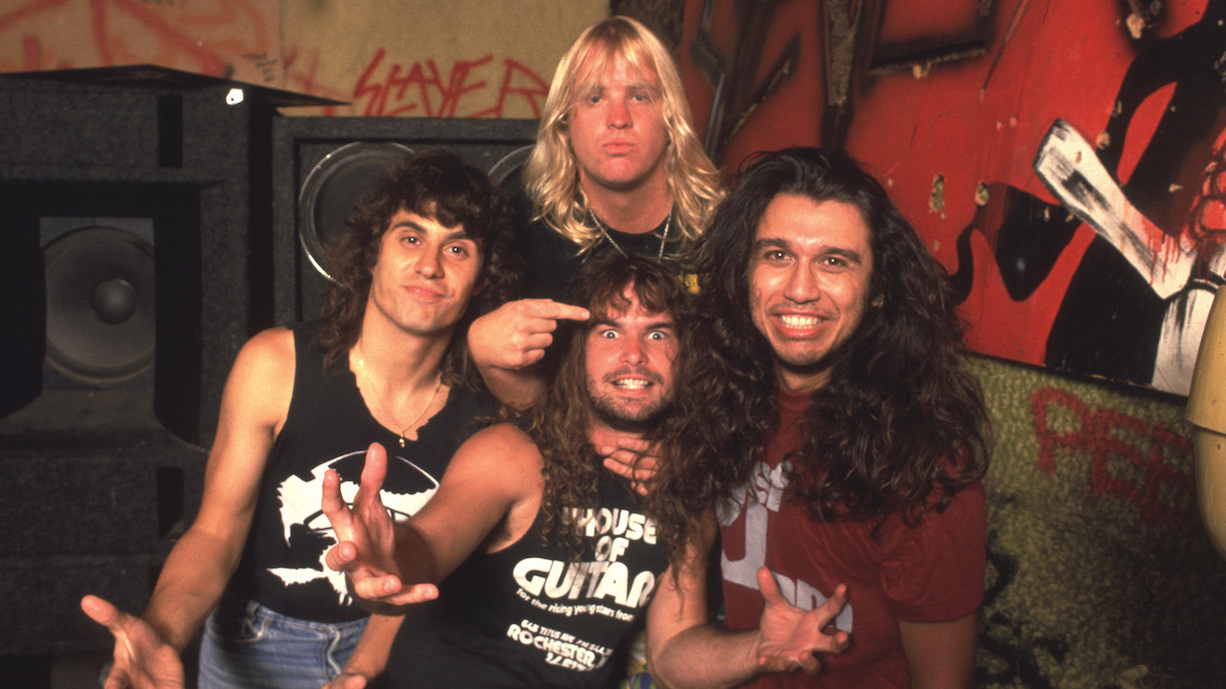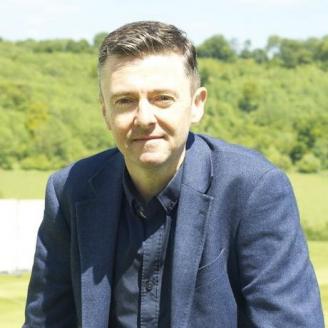It was 1985, almost 1986. The biggest record in the world was Bruce Spingsteen’s chestbeating Born In The USA. The upper reaches of the American charts were populated by bands who had appeared at Live Aid that summer. MTV was four years old, and still 15 months away from the launch of its first specialist show, Headbanger’s Ball. The rock bands that could get airplay included Ratt, Ozzy Osbourne, Def Leppard and Judas Priest. The biggest band in Los Angeles was Mötley Crüe, who were at the head of a new glam rock movement that soon had old arena lags like Ozzy and The Scorpions frosting their hair and wearing eyeliner.
But below the radar, something was stirring. The unruly offspring of heavy metal and punk rock, thrash metal had coalesced three years earlier around a handful of disenfranchised musicians in San Francisco’s Bay Area, with smaller pockets of activity in New York and Los Angeles. The key bands – San Francisco’s Metallica, LA’s Slayer and Megadeth and New York’s Anthrax – had all released records that had been greeted rapturously by those in the know.
The scene was based around a handful of independent labels: Metal Blade and Megaforce in California, Music For Nations in the UK. For three years, they’d sustained themselves without any overlap with the mainstream music industry.
But all that was starting to change. Metallica – the undisputed heavyweight champions of the scene – had signed with major label Elektra in 1985, and their peers were eyeing their progression with a mixture of admiration and envy. By the end of the year, the floodgates had opened, and thrash had planted its size 11 baseball boots squarely in the mainstream.
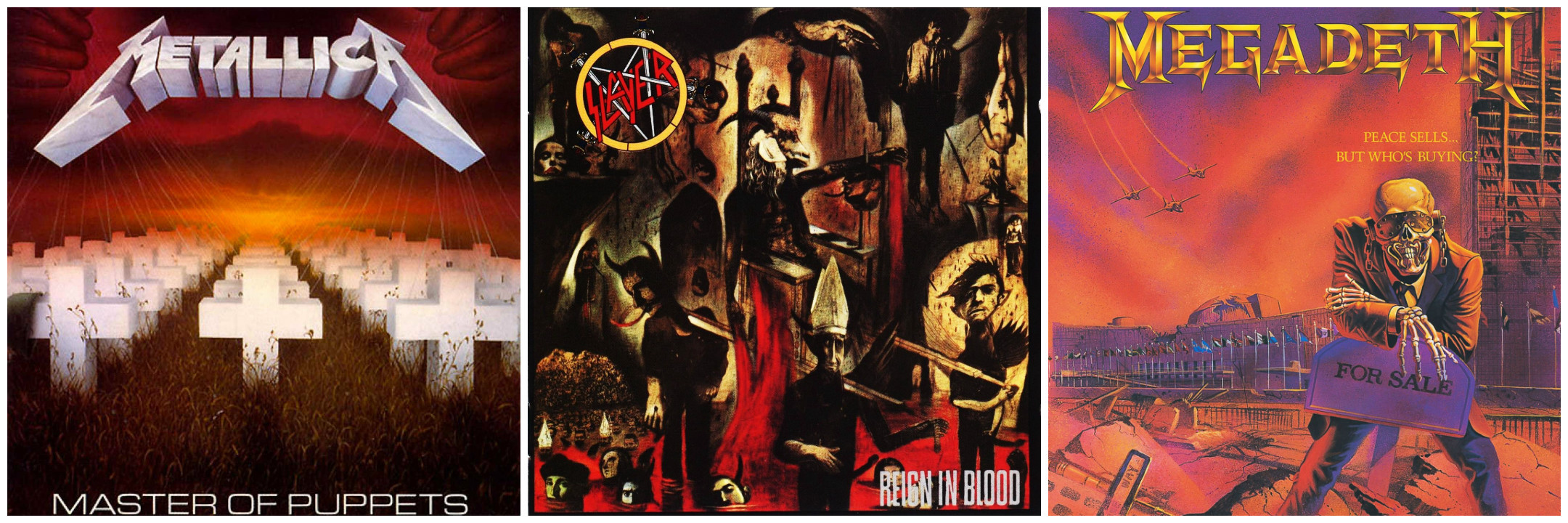
Brian Slagel (Metal Blade Records founder): The thrash scene was super-small. Certainly in the US, all the bands knew each other. I think back then, everyone was just so in love with the music. It was an us-against-the-world mentality.
Lars Ulrich (Metallica): You could send five demo tapes to people, and a week later, a hundred kids had copies. It could spread like brush fire.
Brian Slagel: I guess it’s easy now to think that the big bands of the time were the Big Four, but I think back then, if you were going to name a band that would come from inside that scene who would evetually make it huge, we all would have said Armoured Saint. But it just ended up not ever happening the way we thought it would.
Lars Ulrich: You could certainly argue that me and James at that time were more kind of the squarer guys, ‘cause we were more like, ‘MOTÖRHEAD! IRON MAIDEN!’ Heavy metal T-shirts, and long hair and banging our heads into the wall.
Harald Oimoen (photographer): Dave Mustaine, of course, was extremely bitter about his dismissal from Metallica and drowned himself in alcohol and drugs. I was more than happy to indulge him. Lars and Mustaine still hung out regularly, unbeknownst to the media, where Dave spoke his mind, slagging Metallica at every possible chance.
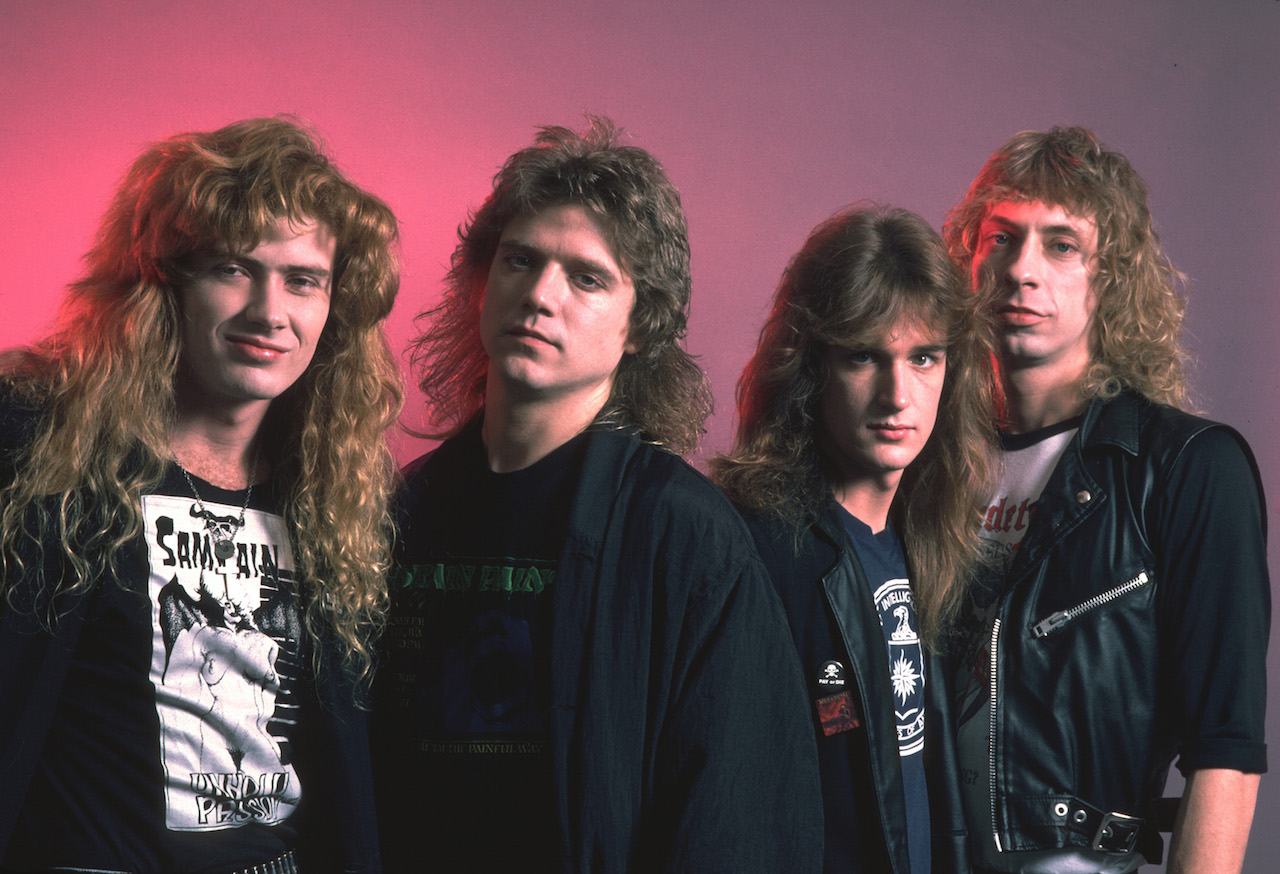
Eric Peterson (Testament guitarist): Paul Baloff (late Exodus singer) was the idol of the Bay Area, because of his personality. He had a real wolf. He’d walk into the clubs with his wolf, taking it everywhere. It had paws like a bear. He had a couple of commands that would make it snarl at you.
Gary Holt (Exodus guitarist): The wolf’s name was By-Tor. Paul had this Jim Jones quality over a crowd. If he said drink the purple Kool-Aid, they drank it. He had that sort of twisted leadership.
Brian Slagel: Slayer was an interesting group because they weren’t particularly good friends. When they would get together it was just magical, but they didn’t really hang out a whole lot.
Tom Araya (Slayer vocalist/bassist): The scene was bigger in Europe. We played the Heavy Sounds festival in Belgium [in late ’85] to 15,000 people. We’d been playing to 300-400 people in clubs in the US.
Gem Howard (Music For Nations Records): Metallica broke Europe before they broke America, and when (managers) Q-Prime took over, they took a hit European act and broke them in America.
- Slayer: Blood Brothers
- Why Load is Metallica's last great album
- The 10 best Megadeth songs you may have overlooked
- The Top 10 greatest Iron Maiden stage sets ever
On 27 December 1985, in a snow-bound Copenhagen, Metallica are putting the final touches to their third album, Master Of Puppets. They’ve been in Denmark for four months, splitting their time between Sweet Silence Studios, where they recorded previous album Ride The Lightning, and their shared suites in the Scandinavia Hotel. The master tapes will be shipped to Los Angeles, to be mixed by Michael Wagener, whose credits include Mötley Crüe and Poison. They don’t know it, but the next 12 months will change everything for them and for the movement they’d come to spearhead.
James Hetfield (Metallica singer/guitarist): The songs themselves remind me of an innocent Metallica. Not stupid, but in a not tarnished, not ruined-by-fame way. The honesty and innocence of living at the studio; still having that fire. And only Metallica on our minds. I think Master Of Puppets was all we ever thought about.
Kirk Hammett (Metallica guitarist): I could tell it was really blossoming into something to be reckoned with. Every song we came up with was like the greatest thing. Every time we’d write another it was like, ‘Oh my god,’ you know.
Lars Ulrich: We braced ourselves for fucking uproar in the thrash community about the sell-outs and the acoustic guitars and all that. But we had to go on that path because that was the truth; that was our truth.
Gem Howard: We had all four of what was to become the Big Four at the same time at Music For Nations. We licensed Slayer for the UK. We had the first two Anthrax albums, the first three Metallica, and we had the first Megadeth album. Metallica were the strongest of those without a doubt.
Charlie Benante (Anthrax drummer): Master Of Puppets moved everything up a notch, that’s for sure.
Brian Slagel: The record was incredible. Honestly, I’m not a huge fan of Kill ’Em All, but Ride The Lightning was tremendous and then they made this album that just changed it up again.
Eric Peterson: It had more production, it sounded cleaner. Sanitarium, everyone was proud of that. That was killer. It was everybody’s song. It was the great hope. It was like, ‘Listen to the production on that, you can sound as good as a Rainbow record’. It was that classic. It was very inspiring.
Gary Holt: Fuck, first time I heard Battery, it was like, ‘That’s awesome’.
James Hetfield: There’s an innocence about it and a real, ‘Fuck you, world’ attitude to it still. And we weren’t very influenced by all of the ‘bigness’ of Metallica. Plus the songs – they have that energy, that fire; they’re still youthful, but we were still growing, and the songs got grander and bigger.
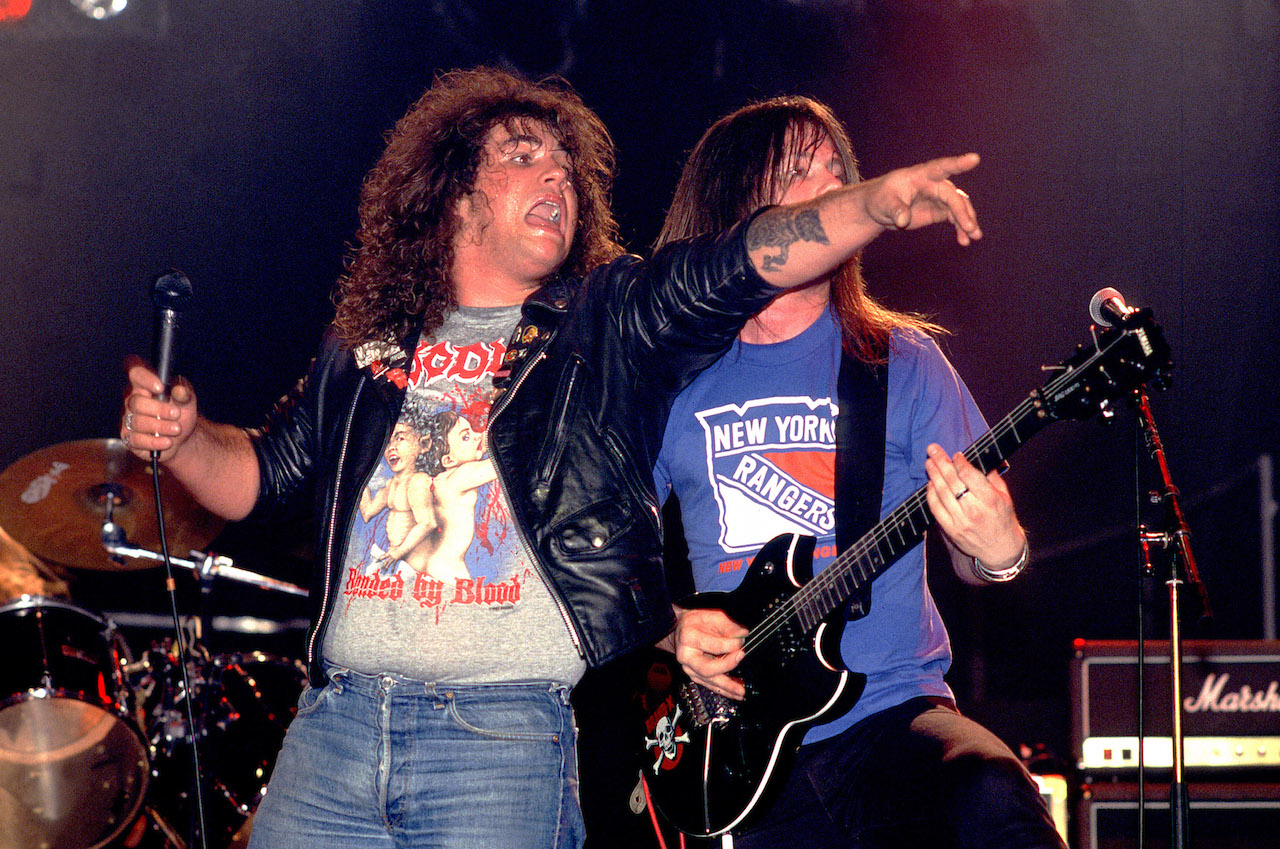
On 31 January, 1986. The Spastik Children – Metallica’s Cliff Burton and James Hetfield (on drums) plus vocalist Fred Cotton and guitarist James McDaniel – play a show at San Francisco dive Ruthie’s Inn, a hub of the Bay Area scene.
Eric Peterson (Testament guitarist): Ruthie’s was in a very dangerous part of San Pablo Avenue, all broken-down looking shops. The dressing room was this little closet behind the stage. Basically you hung out in the crowd, or you got there right when you went on and you walked through the crowd. It was a very dirty, dingy-looking club owned by these blues kind of people, Big Daddy and Earl. They made the best Kamikazes. That was the drink there.
Gary Holt: Paul Baloff and I started crafting Exodus in our own vision – which was basically brutality and violence. The audience responded in kind, and when Ruthie’s Inn opened, it got really insane.
Eric Peterson: Baloff would say, “Any poseurs out there, we want to see their blood on the stage.” The best way to put it would be some kind of Mayan sacrifice ritual.
Robb Flynn (Vio-lence guitarist/future Machine Head singer): At one Exodus show at Ruthie’s, this dude had a cow leg bone, and he’s in the pit running around. This big fuckin’ dude, running around clubbing people with this cow bone…
Lars Ulrich: I know our British counterparts drank a lot, but in some ways it felt like we drank more. In America it was all about the fucking vodka bottles, jumping in the vodka bottles, and anything went from there.
Eric Peterson: Metallica would go to our shows a lot. I’d always see James or Kirk. Lars would pop in, wasted out of his mind. I remember James sitting at Ruthie’s with his hat on backwards. He was just slamming the table with both fists and shouting ‘THE HAUNTING… THE HAUNTING…’.
Gary Holt: The birth of the violent thrasher was Ruthie’s Inn, nowhere else. You had people like the late, great Toby Haines head-walking. I’ve seen that guy make nearly 25 feet using people’s heads as stepping-stones. The guy was about 6’5” and he had some weight to him. The Exodus song Bonded By Blood was about the shows at Ruthie’s when there was broken glass all over the stage and people were all cut up. It was pre-being worried about Hepatitis C and all those things.
Robb Flynn: There’s this kind of myth about the thrash thing that it was all friendly violent fun but it wasn’t. There was such and element of danger, such an element of violence, it wasn’t safe to go.
Eric Peterson: No-one brought guns, it was all switchblades. Everybody had a switchblade.
Bob Nalbandian (Headbanger magazine founder): Everyone thinks speed metal, or thrash metal as it was later called, originated in San Francisco, but you gotta remember three out of the Big Four bands started in Los Angeles.
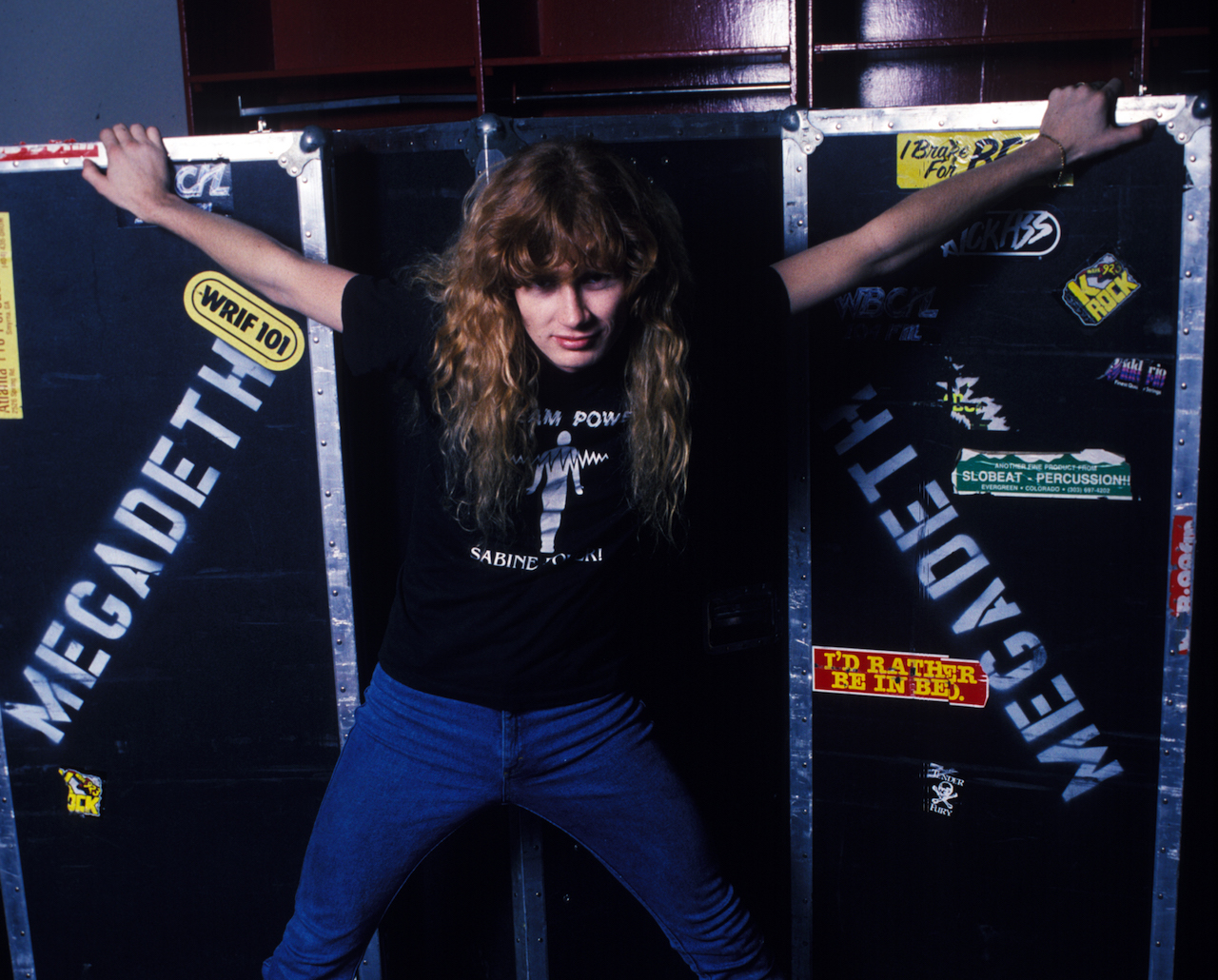
It was to Los Angeles that Dave Mustaine had retreated after being kicked out of Metallica in 1982 for his drinking and drug use. He channelled his fury into Megadeth, the band he founded with bassist Dave Ellefson. The pair are thrash metal’s own Toxic Twins – fully-fledged junkies who struggled to juggle their musical careers and their heroin habits (they spent half of their $8000 advance for 1985 debut album, Killing Is My Business… And Business Is Good, on drugs, alcohol and food). Despite that, much was expected from the follow-up, Peace Sells… But Who’s Buying?.
Dave Mustaine (Megadeth singer/guitarist): I felt what we had done with Metallica was so fresh and invigorating. I’d been living on my own since I was 15. Every day was get up and play guitar and sell pot for a living. That was my existence. To be able to have a real job playing music, c’mon… Once that looked like it wasn’t going to happen, I went into conservation mode. That’s when Megadeth was created, because I had survival skills ever since I was a kid and my parents got divorced. I’d like to think there was a lot of great music that came out of the creation of Megadeth, but I don’t really think it was destined to be any different because there was just so much personality between the four of us.
Dave Ellefson (Megadeth bassist): Living in Los Angeles we were fish out of water because we knew our greener pastures were almost anywhere but Los Angeles. There was an underbelly and an underworld. We were basically homeless and going with any girl we could move in with who would take in a struggling musician, living in my van or our rehearsal room in downtown Los Angeles. Our drug habits were certainly a major inconvenience to lifestyle and certainly cash flow. We went down to hell.
Dave Mustaine: The city we lived in, Los Angeles, it was dangerous. We were dangerous. All of that in-fighting with the glam bands versus the metal bands, man it was dangerous, especially with the heroin. You got guys in Mötley Crüe driving around in exotic cars, people dying behind the wheel. It was a dangerous time back then…
Dave Ellefson: Me and Dave were the two who had no back-up plan, no day job, no college degree, we put it all on the line. Which is why we’d be homeless together. And those things are the DNA of a great band. That’s what Megadeth had.
Dave Mustaine: There were so many days when the other guys were dope sick, lying on the floor puking and shitting their pants and I was thinking ‘Glamorous life!’, you know? But the actual making of the record was much more enjoyable for me. We went into The Music Grinder, which was in was a kind of cool, fashionable area and there were a lot of hot chicks around, a good hamburger joint across the street, a cool hot dog place at the end of the road, and we were living hand to mouth at the time. If we had enough money to get our heroin and a good hot dog, it was a good day.
Bob Nalbandian: I interviewed Dave Mustaine soon after he left, or got kicked out of, Metallica. I thought they were really cocky and to a degree pretty arrogant, but in a good way. If you read or listen back to some of those early interviews I did with Mustaine, you can tell that they had this ‘I don’t give a fuck’ attitude and this total determination to succeed and be the best.
Dave Mustaine: I remember I was smitten with Belinda Carlisle from The Go-Go’s at the time. She came down to the studio to see me one time, and I’d just snorted some heroin and taken a big hit on a joint and she knocks on the door. She was apparently really anti-drugs, and I was totally wasted. I don’t know what would have happened if I’d been sober. Maybe we would’ve dated and had lots of little Go-Go babies. I don’t know, man, but that was one of the lowest points of making that record, having that opportunity dangled in front of my face and losing it.
Lars Ulrich: Whether you heard it for the first time in 1986, or you hear this record for the first time today or tomorrow, Peace Sells is a great heavy metal album. Nothing more, nothing less. It has stood the test of time.
Dave Mustaine: Let me tell you, Peace Sells wasn’t so much a record as it was a way of life. That was it. It was your friends and your enemies.
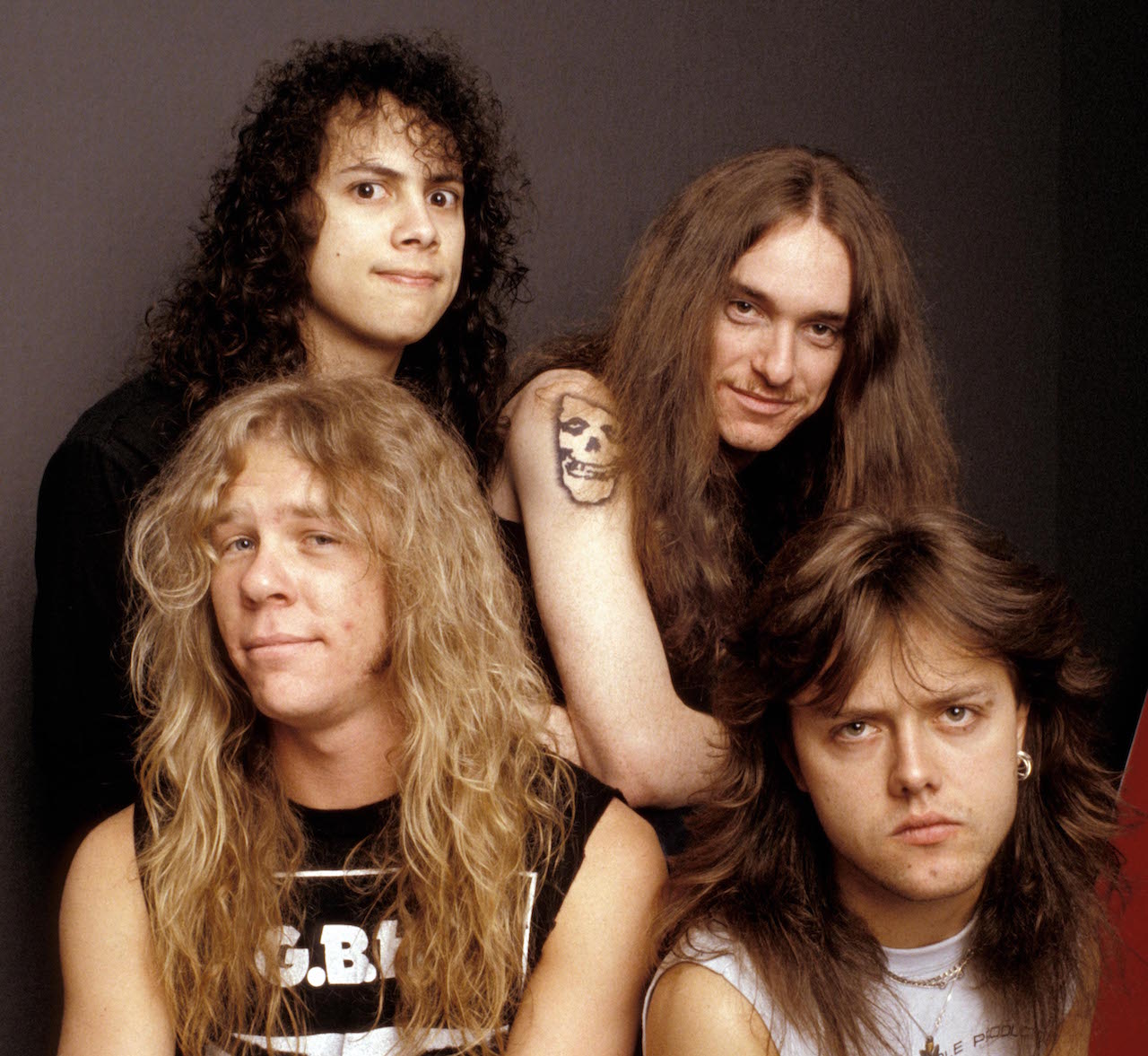
On March 3, 1986, Metallica’s Master Of Puppets appears in stores with a fake parental warning sticker: “The only track you probably won’t want to play is Damage, Inc. due to multiple use of the infamous ‘F’ word. Otherwise, there aren’t any ‘shits,’ ‘fucks,’ ‘pisses,’ ‘cunts,’ ‘motherfuckers,’ or ‘cocksuckers’ anywhere on this record’.” Three weeks later, at the Kansas Coliseum, Wichita, Metallica begin a five month stint supporting Ozzy Osbourne on his US tour. It would help propel Master Of Puppets to its peak position of No. 29 on the Billboard charts – a feat unthinkable even 12 months before.
Mick Wall (journalist): Mötley Crüe went out with Ozzy, came back stars. Def Leppard went out with Ozzy, came back stars. Metallica went out with Ozzy, came back stars. That’s how it worked.
Brian Slagel: The shows with Ozzy were the first time any of these speed metal bands had broken out of the very small scene that they’d come from.
Ozzy Osbourne: I would walk past their bus before shows and hear them playing old Sabbath songs, and I thought they were making fun of me. They wouldn’t talk to me and always kept their distance. I thought it was really weird. I asked their tour manager about it and said, ‘Is this their idea of a joke?’ And he said, ‘No, they think you’re gods’.
Lars Ulrich: It was the first time we got out to middle America. It was the first time that Metallica showed up on the radar screens.
Gary Holt: Metallica were all friends of mine, so I was super happy for them. Soon as they did Ride The Lightning we knew they were onto something. Then it was Master Of Puppets, and you know, they were just better than everyone else.
Lars Ulrich: I remember the last date of the Ozzy tour, in Hampton, Virginia. Our manager, Cliff Burnstein, came down from New York for the last show. So we’re all sitting there in the back of the bus and he said, “You’ve now sold enough records to go and buy houses.” We’d been on the Ozzy tour, at that point for five months. All of us, band and crew on one bus, drinking 12 hours a day, fucking, just living every crazy fantasy about girls and heavy metal. We were completely ignorant to what was going on, you know, on that side of it. I remember Cliff sitting there and going “Fuuuuuckkk, I can buy a house.” The rest of didn’t want to buy a house – we wanted to stay on tour.
Kirk Hammett: I never expected it to be the success it turned out to be. Compared to what else was in the charts, it was a huge orange in amongst the bunch of apples.
Mick Wall: The big difference between Metallica and the rest was this: they had a great record, but they also had Lars and they had Mensch and Cliff Burnstein at Q-Prime. They knew they weren’t going to get on MTV, so they very cleverly said, “We’re not doing a video.” At the same time, Lars is talking to Michael Alago, head of A&R at Elektra, and to promoters and all of this. They were grassroots and corporate at the same time. Lars was a man you could do business with. That was the difference.
Charlie Benante (Anthrax drummer): At the time, Headbanger’s Ball was just starting on MTV. It would piss you off that you only got an hour, and even then you’d get maybe one video in amongst Bon Jovi and Poison, but it was happening. Things were changing.
Thanks to Master Of Puppets, thrash metal had a foothold in the mainstream. Other bands were lining up behind Metallica. One was Slayer, who were working on their third album, Reign In Blood, while Metallica were on the road with Ozzy.
Brian Slagel: There was a competition between the bands over who could be the fastest. Back then, it was called speed metal rather than thrash metal. So Slayer wanted to be the fastest and the heaviest – ‘We have to one-up with everybody else’s stuff’.
Tom Araya (Slayer bassist/vocalist): We took the black metal thing from Venom, and we took it to a different level. The idea behind Reign In Blood was not to do another slow album, like Hell Awaits. A really fast album with short songs. That was the thought process.
Kerry King (Slayer guitarist): What do I remember about writing the songs? [Thinks for a long time] No, not a fucking clue, man…
Brian Slagel: Somebody told me that Rick Rubin was interested in the band, and I thought, “Okay, that’s interesting, Def Jam, a rap label…” I went and met them, and Rubin was definitely more of a metal guy than I thought he’d be. They really wanted the band. They were the most aggressive of anybody that wanted the band.
Tom Araya: What did Rick Rubin bring to it? His musical ear. He made it tolerable. He gave it the Midas touch. What happened on Reign In Blood is that although it’s fast, you can hear everything.
Brian Slagel: The demos of Reign In Blood were around 34 minutes, but the finished album’s about six minutes shorter or something.
Tom Araya: We did the mixes, and I was thinking, “28 minutes..?” I said to Andy (Wallace, engineer), “Is that the total of everything?” He was like, “Er, yeah…” We asked if that was gonna be a problem with Rick. He looked at it and said, ‘Well, an album constitutes 10 songs and you got 10 songs…’
Jeff Hanneman (Slayer): When we got the finished record and saw the cover (artist Larry Carroll’s painting of Satan being carried by men with erections), I was like, “Yeah!” I had the original framed in my house for years.
Kerry King: I thought that the cover looked fucking cool and evil. I wasn’t bothered about everything else. I really didn’t care.
Tom Araya: It was upsetting when (Def Jam’s distributor) Columbia refused to release it. It was because of that song, Angel Of Death (about Nazi physician Josef Mengele).
Jeff Hanneman: I’d seen a documentary and it looked like a cool subject in that if you want to write about evil, and that’s what we wanted to write about, then you won’t get too many human beings that are more so.
Kerry King: It’s written in the way that a show on a documentary channel is written. It relates what happened. It doesn’t try to say it was good or bad.
Lars Ulrich: I think Slayer were the most interesting because they were so extreme. They didn’t give a fuck about anything, which was cool.
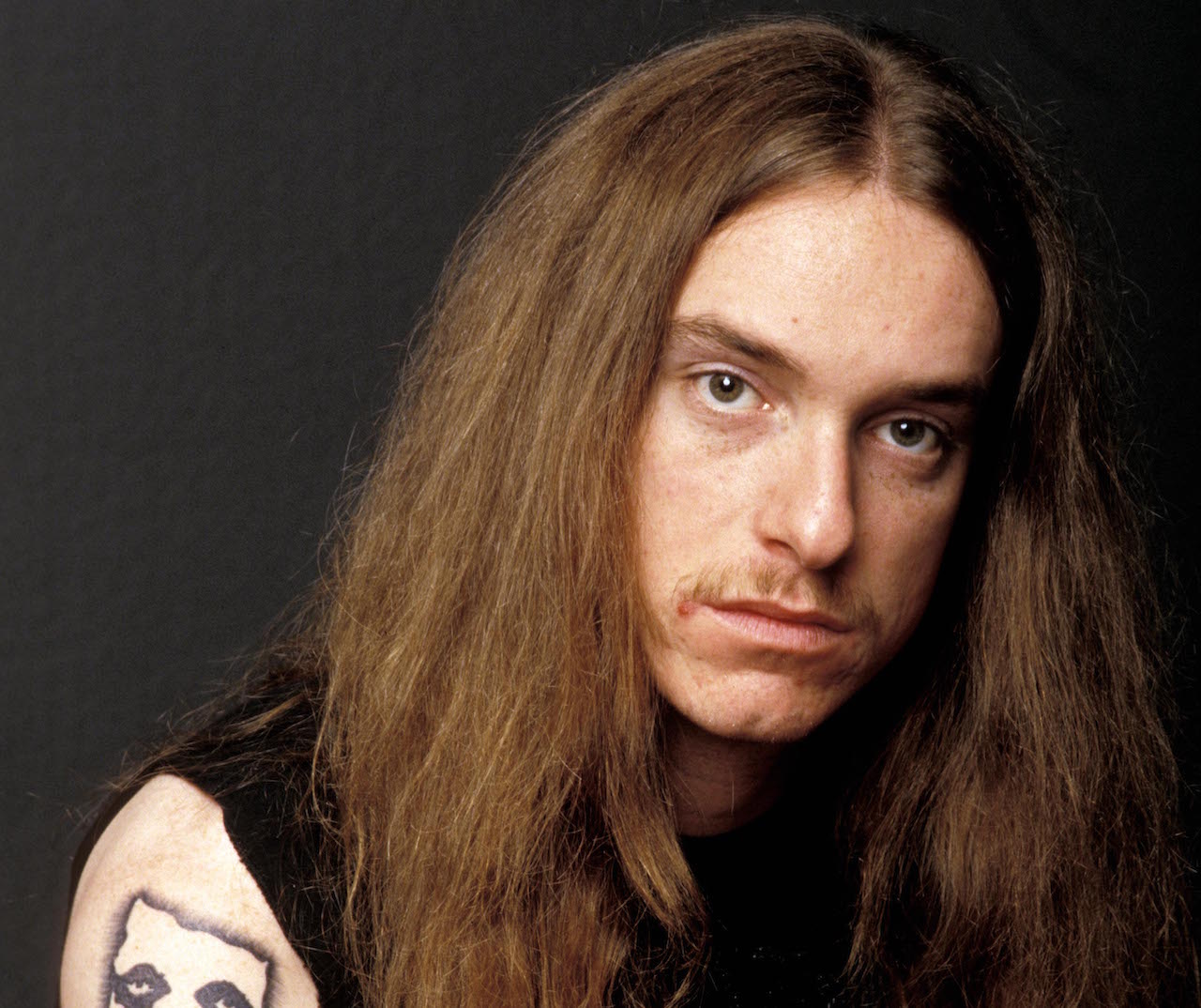
On September 10, 1986. Metallica begin a headline tour of Europe at Cardiff’s St David’s Hall, with Anthrax as the support. On September 27, after a gig in Stockholm, they board their tourbus for the overnight journey to Copenhagen. In the early hours of the morning, near Ljunby, the bus hit a patch of black ice and flips off the road. Cliff Burton is thrown from his bunk and through the window. The bus falls on top of him, killing him. Earlier, the bassist had tossed a coin with Hetfield to decide who got the bunk. It is thrash metal’s first big reality check.
Charlie Benante: We had travelled on ahead. We said goodbye, got to the venue to find kids saying, “Did you hear what happened to Metallica?” I’d had people die in my family, but this was strange.
James Hetfield: I saw the bus lying right on him. I saw his legs sticking out. I freaked. The bus driver was trying to yank the blanket out from under him to use for other people. I just went, “Don’t fucking do that!” I wanted to kill the guy. Our tour manager said, “Let’s get the band together and take them back to the hotel.” And I’m thinking, “The band? There ain’t no band any more. It’s just three guys.”
Gem Howard: There was a Japanese journalist called Terri Mashizuke. She was like a schoolgirl, a tiny little thing. She came into the office in floods of tears. It takes a lot to make a journalist cry.
Eric Peterson: We’d set up a gig for [Megaforce Records co-owners] Jonny and Marsha Z. Jonny was close to Metallica at that point. We were practicing, and Jonny was just staring at the bass drum. He was lost. He said, ‘Cliff died last night’, and he started crying. We all shed some tears.

In November 1986, Metallica made their return to the stage for the first time since the death of Cliff Burton. His replacement was ex-Flotsam And Jetsam man Jason Newsted. By that time, thrash metal had reached critical mass. Metallica found themselves joined at the top table by Slayer and Megadeth, whose albums Reign In Blood and Peace Sells… But Who’s Buying?, were released within three weeks of each other in October and November on major label-distributed Def Jam and EMI subsidiary Capitol respectively. Both landed in the all-important US Top 100. The scene’s detractors might not have liked it, but thrash metal had gone overground. Twenty five years on, 1986 looks and sounds like a landmark year. Things would never be the same for any of the bands involved.
Brian Slagel: They were all maturing and growing as musicians, and they were getting more money and time to do things, and they were working with better people. There was a hunger and a newness to what those American bands were doing, all that kind of culminated in that year.
Gem Howard: You get these peak periods in rock. 1956-57 is the rock’n’roll peak. 1966-67 was the hippy stuff. ’76-77 was the punk thing. ’86-87 was thrash. It’s the 10-year cycle that seems to have finished now.
Charlie Benante: We went from Megaforce to Island, which was home to everyone from U2 to Bob Marley to Anthrax.
Bob Nalbandian: The major labels’ mentality was: “Let’s cash in on the current trend and milk it for all it’s worth.” And that’s the reason why in the few years that followed, major labels started scooping up and signing all sorts of ‘thrash’ bands and it became over-saturated with a lot of crap, which eventually led to the decline of thrash in the late 80s and throughout the 90s.
Dave Ellefson: Getting on a major label was about getting the door open for our fans. 1986 was a big turning-point year, because the ones in the major labels who were fans began to fight the good fight. In order to be great, you gotta be different. And we knew we were different.
Gary Holt: Metallica, Megadeth, Slayer and Anthrax far and away sold the most records. I’ve read someone saying: “Exodus, Testament, those bands were followers, that’s why they’re not in the Big Four.” Exodus precedes everyone but Metallica, but the issue comes down to sales. I have no problem with that. Those bands are all great friends of mine.
Dave Mustaine: We went through a lot of time of feeling like the red-headed step-child, so it was a pretty good feeling, yeah.
Jeff Hanneman: I made my mark on the world, man. I did something. I can die happy.
James Hetfield: There are times when I romanticise it. Life seemed a lot more simple back then.
This feature originally appeared in Classic Rock #166
